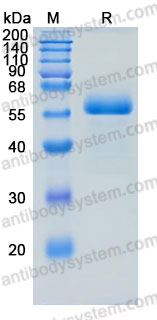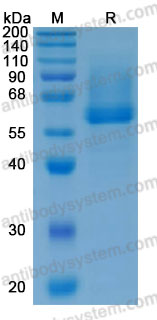Catalog No.
AHA62001
Biological activity
Measured by its ability to inhibit trypsin cleavage of a fluorogenic peptide substrate, Mca-RPKPVE-Nval-WRK(Dnp)-NH2. The IC50 is <2 nM, as measured under the described conditions.
Expression system
Mammalian Cells
Species
Homo sapiens (Human)
Protein length
Pro37-Val449
Nature
Recombinant
Endotoxin level
<0.1 EU/μg of the protein by the LAL method.
Purity
>90% as determined by SDS-PAGE.
Accession
O43278
Applications
Bioactivity, ELISA, Immunogen, SDS-PAGE, WB
Form
Lyophilized
Storage buffer
Lyophilized from a solution in PBS pH 7.4, 5% Trehalose, 5% Mannitol.
Reconstitution
Reconstitute in sterile water for a stock solution. A copy of datasheet will be provided with the products, please refer to it for details.
Shipping
In general, proteins are provided as lyophilized powder/frozen liquid. They are shipped out with dry ice/blue ice unless customers require otherwise.
Stability and Storage
Use a manual defrost freezer and avoid repeated freeze thaw cycles. Store at 2 to 8°C for one week. Store at -20 to -80°C for twelve months from the date of receipt.
Alternative Names
Hepatocyte growth factor activator inhibitor type 1, HAI-1, SPINT1, HAI1, Kunitz-type protease inhibitor 1
SPINT1 Expressed in Epithelial Cells of Choroid Plexus in Human and Mouse Brains., PMID:40507942
Dual STAT3/STAT5 inhibition as a novel treatment strategy in T-prolymphocytic leukemia., PMID:40234614
Loss of tumor cell surface hepatocyte growth factor activator inhibitor-1 predicts worse prognosis in esophageal squamous cell carcinoma., PMID:39799890
Loss of hepatocyte growth factor activator inhibitor type 1 (HAI-1) upregulates MMP-9 expression and induces degradation of the epidermal basement membrane., PMID:39730982
Neutrophil Elastase Targets Select Proteins on Human Blood-Monocyte-Derived Macrophage Cell Surfaces., PMID:39684750
Spint1 disruption in mouse pancreas leads to glucose intolerance and impaired insulin production involving HEPSIN/MAFA., PMID:39627229
Immunohistochemical localization of HCA1 receptor in placenta in presence of fetal growth restriction., PMID:38909565
Unveiling Novel Kunitz- and Waprin-Type Toxins in the Micrurus mipartitus Coral Snake Venom Gland: An In Silico Transcriptome Analysis., PMID:38787076
Cold-shock Domain Protein A (CSDA) Influences Hepatocyte Growth Factor-medicated Cell Proliferation and Metastasis in Gastric Cancer Cells., PMID:38677740
Secreted proteins in plasma and placenta as novel non-invasive biomarkers for intrahepatic cholestasis of pregnancy: A case-control study., PMID:38027820
Machine learning modeling and prognostic value analysis of invasion-related genes in cutaneous melanoma., PMID:37267825
Study on differentially expressed genes and participating pathways of ectopic endometrium in adenomyosis patients with different data sets., PMID:37019419
Deep next-generation proteomics and network analysis reveal systemic and tissue-specific patterns in Fabry disease., PMID:36863609
Weighted Gene Co-Expression Network Analysis of Immune Infiltration in Nonalcoholic Fatty Liver Disease., PMID:36503447
Hypoxia-Inducible Factor-2-Altered Urothelial Carcinoma: Clinical and Genomic Features., PMID:36421334
LncRNA SPINT1-AS1/miR-433-3p/E2F3 positive feedback loop promotes the KRAS-mutant colorectal cancer cell proliferation, migration and invasion., PMID:36274378
Varicocoele-associated male infertility: Cellular and molecular perspectives of pathophysiology., PMID:36040837
Placental DAAM2 is unaltered in preeclampsia, but upregulated by treatment with proton pump inhibitors., PMID:35933758
Insufficiency of hepatocyte growth factor activator inhibitor-1 confers lymphatic invasion of tongue carcinoma cells., PMID:35332604
Circulating serine peptidase inhibitor Kunitz type 1 (SPINT1) in the second trimester is reduced among pregnancies that end in low birthweight neonates: cohort study of 2006 pregnancies., PMID:35331972
Understanding HAIs: Ally proteins in the fight against cancer., PMID:35220685
Diagnosing pleural effusions using mass spectrometry-based multiplexed targeted proteomics quantitating mid- to high-abundance markers of cancer, infection/inflammation and tuberculosis., PMID:35197508
Specificity protein 1-induced serine peptidase inhibitor, Kunitz Type 1 antisense RNA1 regulates colorectal cancer cell proliferation, migration, invasion and apoptosis through targeting heparin binding growth factor via sponging microRNA-214., PMID:35068341
Gene network profiling in muscle-invasive bladder cancer: A systematic review and meta-analysis., PMID:35039218
Role of the polycystic kidney disease domain in matriptase chaperone activity and localization of hepatocyte growth factor activator inhibitor-1., PMID:35020274
Clinical tools and biomarkers to predict preeclampsia., PMID:34954654
The difference in the intracellular Arg/Lys-rich and EHLVY motifs contributes to distinct subcellular distribution of HAI-1 versus HAI-2., PMID:34643933
Circulating syndecan-1 is reduced in pregnancies with poor fetal growth and its secretion regulated by matrix metalloproteinases and the mitochondria., PMID:34400721
Comprehensive Analysis of the Expression and Prognostic Value of SPINT1/2 in Breast Carcinoma., PMID:34381422
Elevated Circulating and Placental SPINT2 Is Associated with Placental Dysfunction., PMID:34299087
HAI-1 is an independent predictor of lung cancer mortality and is required for M1 macrophage polarization., PMID:34185790
Genetics of white color and iridophoroma in "Lemon Frost" leopard geckos., PMID:34166378
Exosome-delivered miR-221/222 exacerbates tumor liver metastasis by targeting SPINT1 in colorectal cancer., PMID:34125460
Maternal circulating SPINT1 is reduced in small-for-gestational age pregnancies at 26 weeks: Growing up in Singapore towards health outcomes (GUSTO) cohort study., PMID:34102451
Anti-tumor activities of Panax quinquefolius saponins and potential biomarkers in prostate cancer., PMID:33841008
The Kunitz-type serine protease inhibitor Spint2 is required for cellular cohesion, coordinated cell migration and cell survival during zebrafish hatching gland development., PMID:33826923
MET transcriptional regulator/serine peptidase inhibitor kunitz type 1 panel operating through HGF/c-MET axis as a prognostic signature in pan-cancer., PMID:33751856
Potential biomarkers and lncRNA-mRNA regulatory networks in invasive growth hormone-secreting pituitary adenomas., PMID:33559847
Targeted deletion of HAI-1 increases prostasin proteolysis but decreases matriptase proteolysis in human keratinocytes., PMID:33486722
Recent Evidence in Epigenomics and Proteomics Biomarkers for Early and Minimally Invasive Diagnosis of Alzheimer's and Parkinson's Diseases., PMID:33357195
Priming of SARS-CoV-2 S protein by several membrane-bound serine proteinases could explain enhanced viral infectivity and systemic COVID-19 infection., PMID:33268377
Evaluating the biological functions of the prognostic genes identified by the Pathology Atlas in bladder cancer., PMID:33200223
Insights into the regulation of the matriptase-prostasin proteolytic system., PMID:33094801
The protective role of estrogen on endothelial and glycocalyx barriers after shock conditions: A microfluidic study., PMID:32988619
Proteolytic cleavage of Podocin by Matriptase exacerbates podocyte injury., PMID:32907879
Proteomic markers with prognostic impact on outcome of chronic lymphocytic leukemia patients under chemo-immunotherapy: results from the HOVON 109 study., PMID:32781097
Mild acidity likely accelerates the physiological matriptase autoactivation process: a comparative study between spontaneous and acid-induced matriptase zymogen activation., PMID:32779152
Inhibition of TMPRSS2 by HAI-2 reduces prostate cancer cell invasion and metastasis., PMID:32778768
Matriptase and prostasin proteolytic activities are differentially regulated in normal and wounded skin., PMID:32617892
Circulating SPINT1 is a biomarker of pregnancies with poor placental function and fetal growth restriction., PMID:32415092


